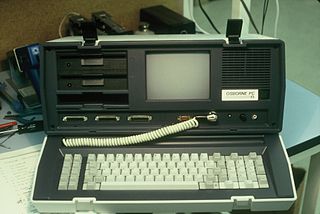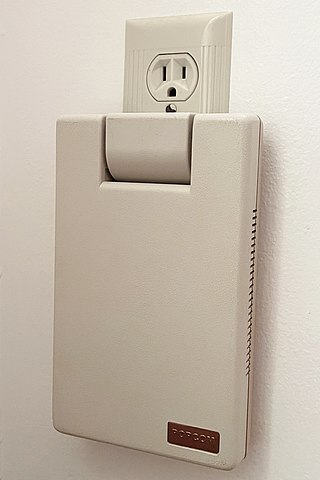Related Research Articles
EasyWriter was the first word processor for the Apple II. It was written by John Draper and released in 1979.

IBM PC–compatible refers to a class of computers that are technically similar to the original IBM PC from 1981 of computer giant IBM. Like the original IBM PC, they use the Intel x86 architecture and are capable of using interchangeable commodity hardware, such as expansion cards. Initially such computers were referred to as PC clones, IBM clones or IBM PC clones, but the term "IBM PC compatible" is now a historical description only, since the vast majority of microcomputers today ever since the 1990s are IBM compatible, but also because IBM no longer sell personal computers anyway, having sold its division to Lenovo in 2005. "Wintel" is a similar description that is more commonly used for modern computers.
Otrona Advanced Systems Corporation was an early Colorado manufacturer of business portable CP/M and MS-DOS compatible computers.

AST Research, Inc., later doing business as AST Computer, was a personal computer manufacturer. It was founded in 1980 in Irvine, California, by Albert Wong, Safi Qureshey, and Thomas Yuen, as an initialism of their first names. In the 1980s, AST designed add-on expansion cards, and evolved toward the 1990s into a major personal computer manufacturer. AST was acquired by Samsung Electronics in 1997 but was de facto closed in 1999 due to a series of losses.

Zenith Data Systems Corporation (ZDS) was an American computer systems manufacturing company active from 1979 to 1996. It was originally a division of the Zenith Radio Company, after they had purchased the Heath Company and, by extension, their Heathkit line of electronic kits and kit microcomputers, from Schlumberger in October 1979. ZDS originally operated from Heath's own headquarters in St. Joseph, Michigan. By the time Zenith acquired Heathkit, their H8 kit computer already had an installed fanbase of scientific engineers and computing enthusiasts. ZDS' first offerings were merely preassembled versions of existing Heathkit computers, but within a few years, the company began selling bespoke systems, including the Z-100, which was a hybrid 8085- and 8088-based computer capable of running both CP/M and MS-DOS.
Corona Data Systems, later renamed Cordata, was an American personal computer company. It was one of the earliest IBM PC compatible computer system companies. Manufacturing was primarily done by Daewoo of Korea, which became a major investor in the company and ultimately the owner.

The Osborne PC is an unreleased IBM PC–compatible personal computer developed between 1983 and 1984 by Osborne Computer Corporation. Only prototypes of the computer were ever produced.

Dolphin is a side-scrolling video game created by Matthew Hubbard for the Atari 2600 and released by Activision in 1983. Dolphin requires the player to use audio cues in order to survive.

The Sharp PC-7000 is a luggable portable computer released by Sharp Electronics in 1985. The PC-7000 was Sharp's second entry into the IBM PC-compatible portable computer market, their first being the PC-5000.

The RoadRunner was an early laptop designed by MicroOffice Systems Technology and introduced in 1983. Weighing roughly 5 pounds (2.3 kg) and featuring a battery able to power it for up to eight hours, the RoadRunner was one of the first clamshell notebook computers ever released.

Popcom was a line of modems marketed by the Prentice Corporation of Sunnyvale, California, introduced in 1984. The line comprised six models—X100, X150, C100, C150, C200, C250—the C models being internal modems meant to plug into a free ISA expansion slot of a PC compatible, while the X models were compact external units intended to be plugged into a wall indefinitely and connected to the computer via a serial cable. The X100 and X150 were noted by the press for their very small physical footprint among its contemporaries in the market.

The Executive Partner is an IBM PC-compatible portable computer that was introduced by the Panasonic Corporation in 1985. The portable computer is AC-powered exclusively, weighs between 28 and 30 pounds (14 kg), and features a built-in printer. The Executive Partner was one of the first affordable portable computers with a plasma display.
Intertec Data Systems Corporation, later Wells American Corporation, was an American computer company active from 1973 to 1991 and based in Columbia, South Carolina.
The MAD-1 is an IBM PC–compatible desktop computer released by Mad Computers, Inc., of Santa Clara, California, in 1984. The computer was noted among the technology press for its unique, modular design and its 80186 microprocessor, the latter seldom used in PC compatibles. It received positive reviews but sold poorly and was pulled from market a year later.
Pronto Computers, Inc., was an American computer company based in Torrance, California, active from 1983 to 1987. During its brief existence, the company released a duo of IBM PC compatible computer systems and a family of high-spec graphics cards. Pronto's first product, the System 16, was widely lauded for its graphical prowess and industrial design; in 1983, I.D. magazine named it the best-designed product in the field of instrumentation and equipment. The System 16 was followed up with the Pronto Transportable Solution, a portable computer. Both it and the Pronto 16 ran the Intel 80186, a microprocessor seldom used in IBM PC compatibles. Pronto Computers went bankrupt shortly after the Black Monday financial crisis of 1987.
Teleram Communications Corporation was a pioneering American computer company that manufactured the first commercially successful portable computers in the mid-1970s. Based in Mamaroneck, New York, Teleram was founded by Charles J. Satuloff in 1973.
The Athena 1 was an early laptop computer released in 1983 by Athena Computer & Electronic Systems, an American computer company active from 1982 to 1987 and based in San Juan Capistrano, California. The Athena 1 was one of the first laptops to make use of solid-state technology as its primary storage medium.

Tava Corporation was a short-lived American computer company that was active from 1983 to 1984 and based in Irvine, California. It was an early manufacturer of IBM PC compatibles. It also operated the CompuShack chain of franchised computer retail stores across the United States.
Lee Data Corporation was an American computer company based in Eden Prairie, Minnesota, and active as a hardware company from 1979 to 1990. It was principally founded by John M. Lee and John Roy to sell data terminal systems compatible with the IBM 3270. It found success going into the mid-1980s, with its offerings praised for their innovations and lower prices compared to IBM's 3270 line, but began faltering in the late 1980s when IBM themselves began adopting such innovations.
References
- ↑ OpenCorporates n.d.
- 1 2 3 Gross 1983a, p. 8D.
- ↑ Gross 1983a, p. 8D; Staff writer 1984b, p. 9B.
- ↑ Gross 1983b, p. 10B.
- ↑ Staff writer 1983a, p. 2C.
- ↑ Gross 1983a, p. 8D; Staff writer 1983a, p. 2C.
- ↑ Staff writer 1984b, p. 9B.
- ↑ Gross 1983b, p. 5B.
- 1 2 Freiberger 1983, p. 31.
- ↑ Gross 1983c, p. 14B.
- ↑ Staff writer 1983c, p. 53; Staff writer 1984a, p. 30.
- ↑ Staff writer 1983b, p. 83; Freiberger 1983, p. 31.
- ↑ Staff writer 1984a, p. 30.
- ↑ Staff writer 1984a, p. 30; Staff writer 1984b, p. 9B.
- ↑ Nadeau 2002, p. 43; Staff writer 1984a, p. 30.
Sources
- "CompuSource Compatible Systems Inc". OpenCorporates. n.d. Archived from the original on February 2, 2023.
- Freiberger, Paul (November 14, 1983). "Abacus will offer a 'portable Apple'". InfoWorld. 5 (46): 31 – via Google Books.
- Gross, Steve (February 19, 1983a). "Customs puts lock on computer look-alikes". Minneapolis Star and Tribune: 8D – via Newspapers.com.
- Gross, Steve (August 26, 1983b). "Computers will be deported, but firm has substitute". Minneapolis Star and Tribune: 5B, 10B – via Newspapers.com.
- Gross, Steve (December 13, 1983c). "3 local makers seek niche in crowded computer field". Minneapolis Star and Tribune: 5B, 14B – via Newspapers.com.
- Nadeau, Michael (2002). Collectible Microcomputers. Schiffer Book for Collectors (Illustrated ed.). Schiffer Publishing. ISBN 9780764316005 – via Google Books.
- Staff writer (February 21, 1983a). "Computer grab is case of Apples, Oranges". St. Cloud Times: 2C – via Newspapers.com.
- Staff writer (September 19, 1983b). "Abacus Desktop Micro Out". Computerworld. XVII (38): 83 – via Google Books.
- Staff writer (October 10, 1983c). "CompuSource Debuts PC Line with Apple IIe-Compatible Portable". Computer Systems News (134): 53 – via Gale.
- Staff writer (January 9, 1984a). "CompuSource to Ship First Abacus Portables". Micro Marketworld. 6 (23): 30 – via Gale.
- Staff writer (March 22, 1984b). "Imports can be risky deal". Minneapolis Star and Tribune: 9B – via Newspapers.com.